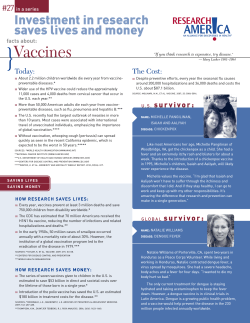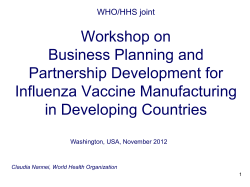
1. QUALITATIVE AND QUANTITATIVE COMPOSITION Infanrix
210 mm 432745 GSK-BEL-Wavre-BEWAV Indonesia-IDN Infanrix 1 Process K BIO_DRW202 No 2. CLINICAL PARTICULARS 2.1. Therapeutic indications Infanrix-Hib is indicated for active immunisation of all infants from the age of 2 months against diphtheria, tetanus, pertussis (DTP) and Hib. Infanrix-Hib does not protect against diseases due to other types of H. influenzae nor against meningitis caused by other organisms. 2.2. Posology The primary vaccination schedule consists of three doses in the first 6 months of life and can start from the age of 2 months. The vaccination calender prescribes that the 3 doses of the primary vaccination are to be administered at the ages of 2,3 and 4 months. To ensure long term protection, a booster dose is recommended for DTP and Hib in the second year of life. FRONT PAGE TYPE SIZE: 10/11,5 HORIZONTAL SCALE: 100% Page 1 of 2 Biologicals Additional Information Panel Material weight: N/A Folded dimensions: 210x25mm Removable parts n.: N/A Datamatrix code value: N/A 2.3. Method of administration Before administration, the liquid Infanrix vaccine contained in the syringe and the reconstituted vaccine are to be inspected visually to verify that they do not contain any foreign bodies or present an unusual appearance. If any anomalies are observed, the liquid vaccine or the reconstituted vaccine should not be used and should be disposed of. The vaccine is to reconstituted by adding the entire contents of the syringe of INFANRIX liquid vaccine to the vial containing the Hib pastille. After adding the INFANRIX liquid vaccine to the pastille, the mixture must be shaken well until the pastille has dissolved completely in the INFANRIX liquid vaccine. 2.4. Contra-indications Infanrix-Hib should not be administered to subjects with known hypersensitivity to any component of the vaccine or to subjects having shown signs of hypersensitivity after previous administration of diphtheria, tetanus, pertussis or Hib vaccines. As with other vaccines, the administration of Infanrix-Hib should be postponed in subjects suffering from acute severe febrile illness. The presence of a minor infection, however, is not a contra-indication. 2.5. Special warnings and special precautions for use Good clinical practise consists of enquiring into the medical history before proceeding with the vaccination (especially with regard to undesirable side effects which may have arisen during an earlier vaccination) and to proceed with a medical examination. Should one of the following events have occurred over time in relation to the administration of a DTP vaccine, the decision to administer subsequent doses of the vaccine containing the pertussis component must be taken in full possession of the facts. There may be circumstances, such as a high incidence of pertussis, when the potential benefits exceed any potential risks, particularly when the events are not associated with permanent after-effects. The events cited below were previously considered as contra-indications for administering whole-cell DTP vaccine, but now it is considered the general precautions should be taken. - temperature of ≥ 40.5°C within 48 hours of vaccination, not due to another identifiable cause - collapse or shock-like state (hypotonic-hyporesponsive episode) within 48 hours of vaccination; - persistent, inconsolable crying lasting ≥ 3 hours, occurring within 48 hours of vaccination; - convulsions with or without fever, occurring within 3 days of vaccination. As with all injectable vaccines, appropriate medical treatment should always be readily available in case of a rare anaphylactic reactions following the administration of the vaccine. For this reason, the vaccine should remain under medical supervision for 30 minutes after immunisation. In the event of a serious anaplylactic reaction, epinephrine is the first treatment of choice. Dose of epinephrine for an infant : 0.01 ml/kg of a 1/1,000 (1 mg/ml) solution of epinephrine administered intramuscularly (max. 0.5 ml). In the absence of any improvement, a second dose can be administered after 5 minutes. Infanrix-Hib must be administered sub-cutaneously to infants suffering from thrombocytopenia or haemorrhaging disorders, given that a haemorrhage is likely to occur after intramuscular administration in these subjects. Following reconstitution, the INFANRIX-Hib vaccine must be injected without delay. As with all diphtheria, tetanus and pertussis vaccines, the vaccine should be administered by deep intramuscular injection and preferably at alternate sites for each injection. Excretion of capsular polysaccharide antigen in the urine has been described following receipt of Hib vaccines, and therefore antigen detection may not have a diagnostic value in suspected Hib disease within 1-2 weeks of vaccination. The reconstituted vaccine is to be injected intramuscularly. However, good clinical practise specifies administering the vaccine sub-cutaneously in patients suffering from thrombocytopenia or who have problems with haemorrhaging (see Precautions) Infanrix-Hib should under no circumstances be administered intravenously A history of febrile convulsions, a family history of convulsive fits, a family history of SIDS and a family history of an adverse event following Infanrix-Hib do not constitute contraindications. 300 mm PHARMA CODE N° 767 1 1. QUALITATIVE AND QUANTITATIVE COMPOSITION Infanrix-Hib contains diphtheria toxoid, tetanus toxoid and three purified pertussis antigens [pertussis toxoid (PT), filamentous haemagglutinin (FHA) and pertactin (69 kiloDalton outer membrane protein)] adsorbed onto aluminium salts. It also contains purified polyribosylribitol-phosphate capsular polysaccharide (PRP) of Hib, covalently bound to tetanus toxoid. The diphtheria and tetanus toxins obtained from cultures of Corynebacterium diphtheriae and Clostridium tetani are detoxified and purified. The acellular pertussis vaccine components (PT, FHA and pertactin) are prepared by growing phase I Bordetella pertussis from which the PT and FHA and pertactin are extracted, purified and irreversibly detoxified. The diphtheria toxoid, tetanus toxoid and acellular pertussis vaccine components are adsorbed on aluminium salts. The final vaccine is formulated in saline. The Hib polysaccharide is prepared from Hib, strain 20,752 and coupled to tetanus toxoid. After purification the conjugate is lyophilised in the presence of lactose as stabiliser. Infanrix-Hib meets the World Health Organization requirements for manufacture of biological substances, of Hib conjugate vaccines and of diphtheria, tetanus, pertussis and combined vaccines. An 0.5 ml dose of the vaccine contains not less than 30 International Units (IU) of diphtheria toxoid, 40 IU of adsorbed tetanus toxoid, 25 µg of PT, 25 µg of FHA, 8 µg of pertactin and 10 µg of purified capsular polysaccharide of Hib covalently bound to approximately 30 µg tetanus toxoid. PHARMA CODE N° 767 432745 210 mm Vaccination does not necessarily give protection against all infections or disease. In the case of clinical symptoms, treatment should not be postponed, irrespective of the stage of vaccination the patient is at. 1 432745 GSK-BEL-Wavre-BEWAV 2.6. Interactions with other medicaments and other forms of interaction Infanrix-Hib can be administered either simultaneously or at any time before or after a different inactivated or live vaccine. Different injectable vaccines should always be administered at different injection sites. As with other vaccines it may be expected that in patients receiving immunosuppressive therapy or patients with immunodeficiency an adequate immunologic response may not be achieved. 2.7. Pregnancy and lactation As Infanrix-Hib is not intended for use in adults, information on the safety of the vaccine when used during pregnancy or lactation is not available. Indonesia-IDN Infanrix 1 Process 2.8. Undesirable effects In controlled clinical studies, signs and symptoms were actively monitored and recorded on diary cards following the administration of the vaccine. The following table summaries the local and general solicited symptoms reported within 48 hours of vaccination as a percentage of doses administered. K Local and general solicited symptoms BIO_DRW202 No Local symptoms: - pain (severe) - redness (>2 cm) - swelling (>2 cm) General symptoms: - fever ≥38°C (rectal) - fever ≥ 39.5°C (rectal) - loss of appetite - restlessness - unusual crying - vomiting - diarrhoea BACK PAGE TYPE SIZE: 10/11,5 HORIZONTAL SCALE: 100% Page 2 of 2 Biologicals Additional Information Panel Material weight: N/A Folded dimensions: 210x25mm Removable parts n.: N/A Datamatrix code value: N/A Infanrix-Hib Primary + booster (2336 doses administered) 0.1% 0.5% 0.6% 7.7% 0.2% 11.3% 17.6% 15.7% 7.4% 9.0% The following unsolicited symptoms have been reported with a frequency of > 1% (total of 2336 documented doses); these are not necessarily related to the vaccine: • gastro-intestinal system (1.1% or less): gastroenteritis, enteritis; • resistance mechanism (2.5% or less): viral infection, otitis media; • respiratory system (5.7% or less): pharyngitis, coughing, rhinitis, respiratory disorder, bronchitis, upper respiratory tract infection; • vision (1.3% or less): conjunctivitis. Convulsion or hypotonicity in infants, followed by full or spontaneously recovery, were only very rarely reported. 3. PHARMACOLOGICAL PROPERTIES Relevant information for vaccines DTPa component: One month after the primary vaccination course more than 99.6% of infants vaccinated with Infanrix-Hib had antibody titers of ≥0.1 IU/ml to tetanus and diphtheria. The mean vaccine response to the pertussis antigens (PT, FHA, pertactin) was 97.7%. Following administration of Infanrix-Hib booster in the second year of life, 100% of infants had antibody titers of ≥0.1 IU/ml to both diphtheria and tetanus. The booster response to the pertussis antigens was seen in 100% of these infants. The protective efficacy of a primary vaccination course of Infanrix against typical pertussis (as defined by World Health Organization) was assessed up until the time of booster in a prospective blinded household contact study. Based on data collected from secondary contacts in households where there was an index case with typical pertussis, the protective efficacy of the vaccine was 88.7%, with a two-sided 95% confidence interval of 76.6% to 94.6%. Hib component: A titre of ≥0.15 µg/ml was obtained in 95-100% of infants one month after the completion of the primary vaccination course. A titre of ≥0.15 µg/ml was obtained in 100% of infants one month after the booster dose and all infants had a titre of ≥1 µg/ml with 95.5% over 10 µg/ml. 4. PHARMACEUTICAL PARTICULARS 4.1. Incompatibilities Infanrix-Hib should not be mixed with other vaccines in the same syringe, unless specified by the manufacturer. 4.2. Shelf-life The expiry date of the vaccine is indicated on the label and packaging. 4.3. Special precautions for storage The lyophilised Hib vaccine and the DTPa vaccine have to be stored at +2°C to +8°C and be protected from light. The DTPa vaccine should not be frozen. Discard if it has been frozen. The lyophilised Hib vaccine is not affected by freezing. 4.4. Instructions for use/handling The lyophilised Hib vaccine is presented as a white pellet and the DTPa vaccine is a suspension. The DTPa vaccine and reconstituted vaccine should be inspected visually for any foreign particulate matter and/or variation of physical aspect prior to administration. In the event of either being observed, discard the vaccines. The vaccine must be reconstituted by adding the entire contents of the container of the DTPa vaccine to the vial containing the pellet. After the addition of the DTPa vaccine to the pellet, the mixture should be well shaken. The reconstituted vaccine must not be injected before complete dissolution of the pellet. After reconstitution, Infanrix-Hib should be injected promptly, and it is stable for 2 hours at temperature 21°C ± 1°C. Presentations Box, 1 prefilled syringes 0,5 ml (Infanrix) + 1 vial 0,5 ml (Hiberix) Infanrix is a trademark. HARUS DENGAN RESEP DOKTER Reg. No. DKI0376701544A1 Imported by PT. SmithKline Beecham Pharmaceuticals Bogor, Indonesia International data sheet version 1.0-rev (27/10/95) © GlaxoSmithKline Biologicals s.a. 2001 Manufacturer/Fabricant/Fabricante: GlaxoSmithKline Biologicals s.a. Rue de I’Institut 89, B-1330 Rixensart, Belgium. Tel.: (32.2) 656 81 11 Fax: (32.2) 656 80 00 Telex: 63251 432745 300 mm Human Immunodeficiency Virus (HIV) infection is not considered as a contra-indication.
© Copyright 2025









